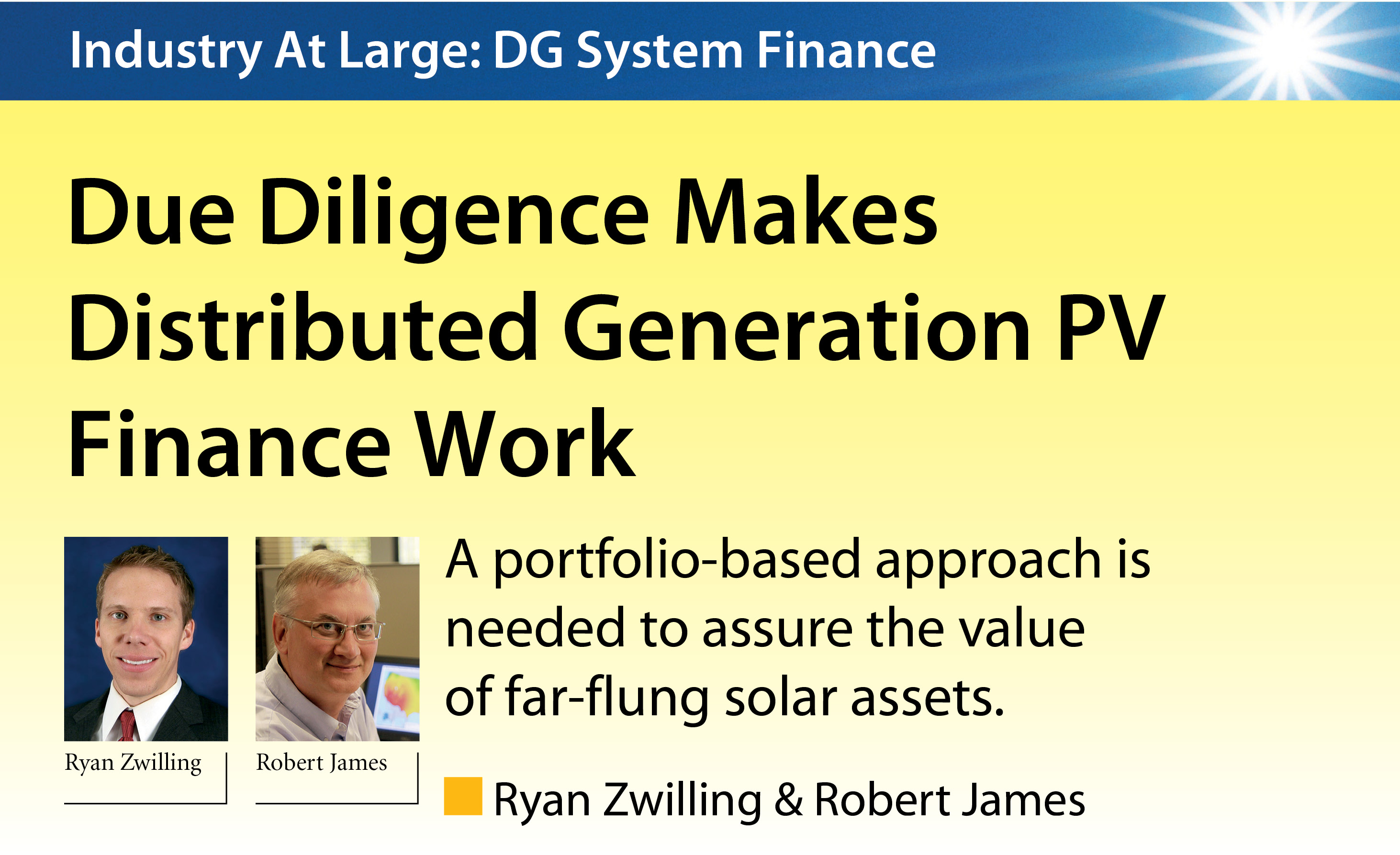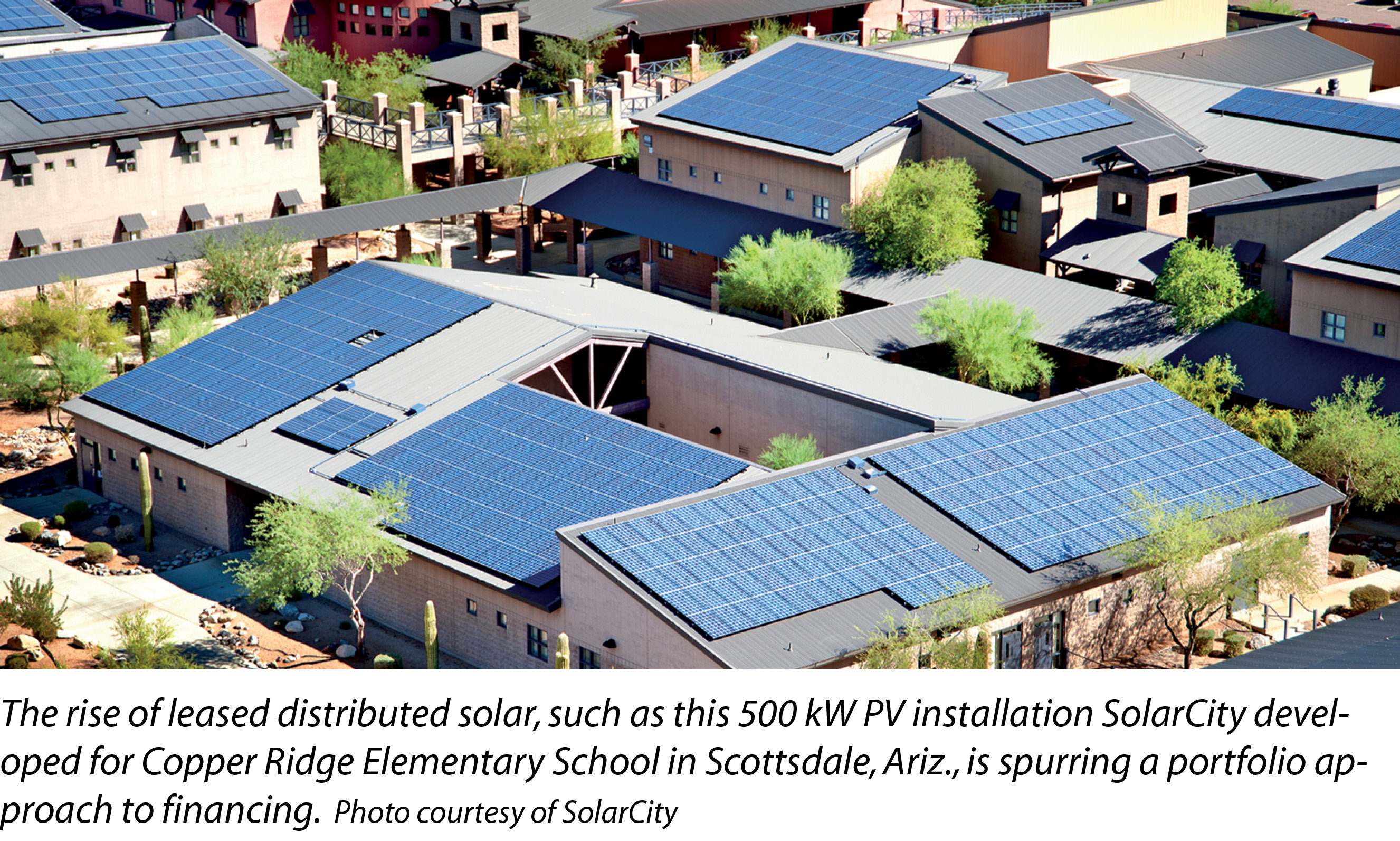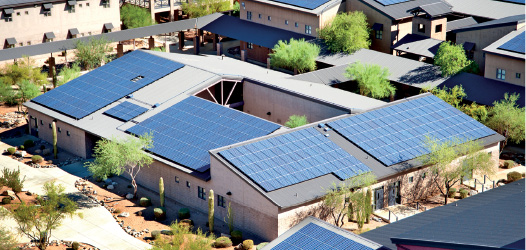

301 Moved Permanently
Large, single-site photovoltaic projects lend themselves to a variety of established due diligence protocols in order to quantify the project’s viability for both developers and financiers. However, one of the fastest-growing sectors of the renewables industry involves the use of distributed generation (DG) assets to supply power to the grid. Due to their smaller scale, DG projects call for portfolio financing, and the cost-prohibitive nature of inspecting/evaluating each individual system necessitates a different approach for due diligence of such assets.
In generic terms, a DG system is the use of any small-scale power generation technology to provide power at or near the point of electrical load. Such systems can range from residential (typically less than 10 kW in size) roof-mounted PV power plants, to larger (1 MW and up) “behind-the-meter” arrays in commercial or industrial settings. Traditionally, these DG solar systems were simply purchased outright by the home or business owner with the available cash for such an investment. The systems delivered power to the home or business or, when excess energy was available, to the grid - typically through a net-metering arrangement with the local utility.
The rise of DG financing
The DG solar market has seen explosive growth in the last five years, as firms such as Sunrun, SolarCity, Clean Power Finance, Sungevity and NRG Solar RSS have set up business models where they offer prospective PV customers low- or no-cost down payment pricing options. These so-called “sponsors” sign customers up for solar leases and/or power purchase agreements (PPAs).
These sponsors have developed streamlined approaches to sales, design, permitting, installation and asset management that have resulted in competitive cost structures. This gives them the ability to offer customers solar leases at an energy rate that is lower than current or projected utility rates in several electricity markets.
The other key advantage that third-party owners/investors have for DG solar is that they can more efficiently take advantage of the tax credits, incentives or accelerated depreciation benefits that are available than can the average homeowner. Sponsor firms know how to securitize DG solar assets into portfolios or funds that often consist of several thousand residential-scale systems and/or smaller numbers of commercial-scale systems. An investor with “tax appetite” is brought in - often up front - to provide construction funding for the assets slated for a particular portfolio. 
DG portfolio review
Tax equity investors - as well as lenders and ratings agencies - have taken various approaches to due diligence of DG portfolio investments in the last few years. Many of the early deals were sufficiently short-term or “de-risked” from the investor perspective - no independent engineer was needed.
Over the last couple of years, there has been a push to reinvest the capital tied into these systems by lengthening the deal tenor to 10, 15 or 20 years to reflect a larger portion of the assets’ life. This has increased the need for technical expertise to confirm the long-term expectations for the performance of the portfolio. Technical considerations unique to DG solar portfolios include their geographic and climatic diversity, as well as their diversity in module and inverter technologies.
Because it is unrealistic and prohibitively expensive to analyze each PV system in a portfolio, the procedures used to implement a fund of PV systems are analyzed and audited, and historical production data is used to determine probabilistic estimates for a new portfolio’s production. This estimate thus correlates to the portfolio revenue stream - subject to portfolio-related expenses - thereby enabling a potential investor to determine the risk-adjusted return on the investment.
Technical review of a DG portfolio typically involves evaluation of the following:
- Engineering, design and installation procedures;
- Equipment selection, principally focused on PV modules and inverters;
- The sponsor’s energy forecast methodology for forecast consistency and reliability;
- The sponsor’s actual fleet performance;
- The lease and/or PPA, with a focus on evaluating expected payout from customer guarantees, as well as sponsor operations and maintenance (O&M) and warranty responsibilities;
- The O&M and/or management agreement between the sponsor and the fund itself;
- Third-party inspection reports and audits of other quality assurance (QA) and quality control (QC) documentation for a subset of systems, often accompanied by site visits; and
- Financial model of production, O&M and administrative cost assumptions.
One of the key cost centers for the DG solar sector is sales. To accelerate the sales process, many firms have automated proposal and bid tools that generate energy forecasts in situ, often based solely on basic roof or site measurements.
Batch energy forecasts, such as those using the PVWatts tool developed by the National Renewable Energy Laboratory, are quick but relatively uncertain, leading to a somewhat wide distribution of actual production vs. expected production. Fortunately, despite the wide distribution, we have found that on average, the actual production of DG PV portfolios has historically been greater than predicted by PVWatts to varying degrees, depending on the portfolio makeup. This is due principally to the inherent conservatism built into the internal default settings of the PVWatts tool, which most sponsors decline to modify directly.
One risk facing the DG solar sector is inherent in its distributed nature. Each sponsor has its own processes for disseminating best practices for system design and installation to its various staff and subcontractors working in local markets across the country. Our audits have found that installed systems generally conform to the sponsors’ requirements.
Lapses in construction quality or QA/QC documentation are still seen, to varying degrees, in most portfolios, although the frequency of observed installation issues has decreased somewhat over time. Lapses in construction quality and/or O&M responsiveness and asset management can all impact energy yield, O&M costs and the service life of the PV system via roof integrity, quality of wiring, communications and inverter troubleshooting, and other factors.
Enter the independent engineers
Most financed DG portfolios contain equipment from known vendors that have passed through a qualification process undertaken by the sponsor. Aside from industry standard warranties and various product and manufacturing certifications, more detailed information regarding a product’s track record may or may not be available via the sponsor.
Batch testing of specific products to be used in a portfolio is not commonly performed at this time, raising the potential for lapses in manufacturing quality that could cause underperformance or downtime that must be addressed under warranty. Thankfully, there have been few serial defects in PV modules in the DG portfolios we have reviewed to date.
Inverters, on the other hand, have seen the need for troubleshooting and/or replacement with varying levels of frequency. An independent engineer is typically tasked with evaluating ongoing production expectations that account for such issues. Probabilistic forecasts for production - including degradation - and availability, as well as stress cases for the financial model, can be adjusted to match the risk profile of a specific portfolio based on its track record, technology diversity and QA/QC information available.
Aside from PV modules and inverters, an independent engineer may perform limited reviews of other balance-of-system components from a design process perspective, as well as during the review of a subset of audited systems. Communication issues are the most common category of troubleshooting noted in our O&M logs to date.
Extended lapses in communication with a PV system can make it more difficult to accurately track system production and also pose a challenge to third parties working with the data. Accurate and reliable metering and communication is important for energy production measurement and logging, and helps demonstrate to customers that their monthly solar invoices are more than offset by energy savings.
A key deliverable from the independent engineer review of a DG portfolio is an independent baseline and uncertainty-adjusted expectation of monthly production, often broken down by region. Uncertainty can be introduced by the sponsor’s estimates and quality of the production data itself with regard to reliability, repeatability of sponsor forecasts and representativeness of the portfolio as compared with the regional and technology composition of the production data set. Uncertainty can also come from physical variables, such as solar resource variability and PV system degradation and availability.
The effect of the portfolio is factored into the uncertainty analysis using tools that account for the level of statistical independence of regional production, for example. Using a high-quality data set of production data representative of the portfolio results in the reduction of uncertainty when compared to the uncertainty of estimating energy solely via PV simulation software.
The end result of this assessment is the establishment of the portfolio’s probabilities of exceedence for production over a period of years. Such metrics are typically used by portfolio lenders and investors in their own valuation or debt-sizing analyses.
A key issue during portfolio due diligence is establishing the reasonableness of the sponsor’s approach to maintaining the systems in a manner that justifies the energy production assumptions over time. The independent engineer’s review of the O&M plan should cover the overall plan and providers (e.g., involved third parties), including the scope of services and assigned responsibilities. In addition, the review should determine whether the scope of the O&M plan is sufficient to do the following:
- Maintain equipment in a safe and functional condition;
- Perform all supplier maintenance to fulfill warranty requirements; and
- Maintain cleanliness of panels in line with energy forecast soiling assumptions.
Finally, the independent engineer must review whether the projected cost of the work is reasonable.
From about four years of available operating history, we have noted a decline in O&M event frequency over time, which is consistent with expectations that DG solar energy systems are generally more reliable after the first year of operation, where troubleshooting or maintenance visits are somewhat more common.
Long-term inverter repair or replacement costs are generally acknowledged to be the biggest source of O&M-related uncertainty. An independent engineer can evaluate expected O&M costs in the context of the portfolio’s technology makeup, such as the historical or expected reliability and maintenance needs for various central inverters, string inverters or microinverters. Aside from on-site O&M costs, an independent engineer can also review sponsor cost information with respect to managing and administering the portfolio over time.
DG PV portfolios are a new and exciting development within the PV industry. As financing of such assets stretches over longer terms, independent engineering reviews of such portfolios have been used by investors to gain confidence in the long-term revenue and expense assumptions associated with the operation of these assets. These process-based analyses lend themselves well to repeated use, bringing down the cost of technical due diligence for subsequent portfolios and allowing the industry to access capital in a cost-effective manner to fuel its currently rapid growth. S
Industry At Large: DG System Finance
Due Diligence Makes Distributed Generation PV Finance Work
By Ryan Zwilling & Robert James
A portfolio-based approach is needed to assure the value of far-flung solar assets.


si body si body i si body bi si body b
si depbio
- si bullets
si sh
si subhead
pullquote
si first graph
si sh no rule
si last graph